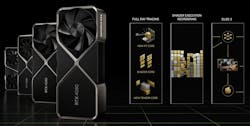GTC Fall 2022 Keynote: GeForce Beyond
NVIDIA founder and CEO Jensen Huang gives his usual GTC keynote packed full of new announcements and amazing graphics, and explains why last year's technology has been blown away by hardware that's just emerging. It runs 90 minutes, so check out the time codes below if you want to skip ahead to a particular section in the video or just read about it here.
The starting demo is the RacerX real-time simulation using NVIDIA RTX. It was built in NVIDIA's Omniverse and presents real-time animation generated by a GPU instead of being rendered to a video file that would playback with the same functionality and resolution. This means that a game or a virtual environment can be rendered as needed.
NVIDIA developed a new GPU to get this real-time presentation to run fast and smooth. It's the NVIDIA Ada Lovelace, named for the noted mathematician. The GPU has 76 billion transistors and utilizes TSMC's N4 transistor process. It works with Micron's latest G6X memory.
The chip incorporates third-generation ray-tracing RT cores that deliver 200 RT TFLOPS. It doubles the ray-triangle intersections performance versus that of previous versions and the shaders have twice the power efficiency.
The system employs a new micro mesh engine and new Tensor cores. The shaders support shader execution reordering (SCR), allowing for more efficient hardware utilization. The system also supports the third-generation deep-learning super resolution (DLSS); the demo provides some impressive graphic effects. The chip can be found in the new RTX 4080 (Fig. 1).
There were plenty of other announcements in the keynote, including DRIVE Thor. This hardware platform targets cars and robots. The other robotic announcements were the Nova Orin and the Jetson Orin Nano. The former is a robot that includes the latter, along with a host of sensors, on a small rolling robot about the size of a Roomba. More on that in the near future.
CV-CUDA also was announced in the keynote. Underneath a lot of the video content, it's a set of highly integrated and optimized video-processing software components.
QODA, the quantum optimized device architecture, was mentioned as well, although this was announced earlier in the year. It's a tool to assist in developing applications for future quantum-computing hardware.
The large language models (LLM) was another topic addressed in the presentation. It targets platforms like NVIDIA's Hopper in the cloud, where large amounts of compute power can be used to provide natural language processing.
Lastly, the keynote brought up the Unified Compute Framework (UCF). This is NVIDIA's answer to the complexity of programming graphical and AI applications using the company's other services. The UCF Studio is a graphical programming environment akin to NI's LabVIEW, although the two are only similar in their graphical programming nature. Some like to call this a no-code environment, but it's really just a graphical programming language tuned for UCF.
The demo that was shown runs on AWS. NVIDIA's Ominverse Avatar Cloud Engine (ACE) played a big role in the demo.
Video Time Codes
0:00:00 Introduction
0:01:00 RacerX real-time simulation using NVIDIA RTX
0:04:28 NVIDIA Ada Lovelace
0:13:00 DLSS demo
0:18:00 RTX 4080
0:22:00 Omniverse overview
0:37:00 DRIVE Thor
0:49:40 Jetson Orin Nano and the Nova Orin
0:56:00 Isaac robotics platform in the cloud
1:04:00 CV-CUDA - set of highly integrated components
1:05.32 QODA - quantum optimized device architecture
1:08.40 Large language models (LLM)
1:21:48 Unified Compute Framework (UCF) tools running on AWS
1:29.38 Deloitte services
1:30:00 Closing
About the Author
William G. Wong
Senior Content Director - Electronic Design and Microwaves & RF
I am Editor of Electronic Design focusing on embedded, software, and systems. As Senior Content Director, I also manage Microwaves & RF and I work with a great team of editors to provide engineers, programmers, developers and technical managers with interesting and useful articles and videos on a regular basis. Check out our free newsletters to see the latest content.
You can send press releases for new products for possible coverage on the website. I am also interested in receiving contributed articles for publishing on our website. Use our template and send to me along with a signed release form.
Check out my blog, AltEmbedded on Electronic Design, as well as his latest articles on this site that are listed below.
You can visit my social media via these links:
- AltEmbedded on Electronic Design
- Bill Wong on Facebook
- @AltEmbedded on Twitter
- Bill Wong on LinkedIn
I earned a Bachelor of Electrical Engineering at the Georgia Institute of Technology and a Masters in Computer Science from Rutgers University. I still do a bit of programming using everything from C and C++ to Rust and Ada/SPARK. I do a bit of PHP programming for Drupal websites. I have posted a few Drupal modules.
I still get a hand on software and electronic hardware. Some of this can be found on our Kit Close-Up video series. You can also see me on many of our TechXchange Talk videos. I am interested in a range of projects from robotics to artificial intelligence.


